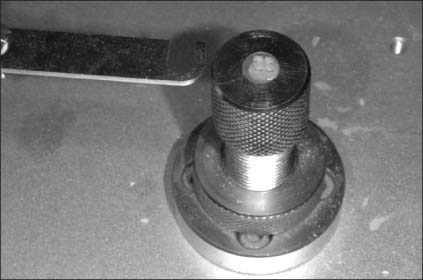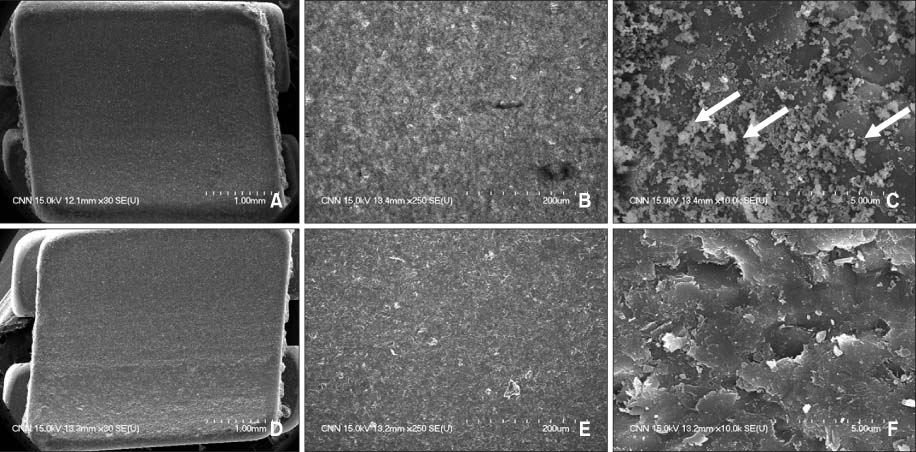Korean J Orthod.
2010 Jun;40(3):184-194. 10.4041/kjod.2010.40.3.184.
Effect of tribochemical silica coating on the shear bond strength of rebonded monocrystalline ceramic brackets
- Affiliations
-
- 1Department of Orthodontics, School of Dentistry, Pusan National University, Korea. daniel.sw.kang@gmail.com
- KMID: 1459572
- DOI: http://doi.org/10.4041/kjod.2010.40.3.184
Abstract
OBJECTIVE
The purpose of this study was to investigate the effect of tribochemical silica coating on the shear bond strength (SBS) of rebonded ceramic brackets using nano-filled flowable composite resin.
METHODS
A total of 60 premolars were prepared and divided into 4 equal groups as follows: Tribochemical silica coating (TC) + Transbond XT (XT), TC + Transbond supreme LV (LV), Sandblast treatment (SA) + XT, SA + LV. Treated ceramic brackets were rebonded on the premolars using each adhesive. All samples were tested in shear mode on a universal testing machine.
RESULTS
SBS of silica coated groups were high enough for clinical usage (TCLV: 10.82 +/- 1.82 MPa, TCXT: 11.50 +/- 1.72 MPa). But, SBS of the sandblast treated groups had significantly lower values than the tribochemical silica coated groups (SALV, 1.23 +/- 1.16 MPa; SAXT, 1.76 +/- 1.39 MPa; p< 0.05). There was no difference between the shear bond strength by type of adhesive. In the silica coated groups, 77% of the samples showed bonding failure in the adhesive. In the sandblast treated group, all bonding failures occurred at the bracket-adhesive interface.
CONCLUSIONS
The result of this study suggest that newly introduced nano-filled flowable composite resin and tribochemical silica coating application on debonded ceramic bracket bases can produce appropriate bond strengths for orthodontic bonding.
MeSH Terms
Figure
Reference
-
1. Kew KK, Djeng SK. Recycling ceramic brackets. J Clin Orthod. 1990. 24:44–47.2. Andrews LF. The six keys to normal occlusion. Am J Orthod. 1972. 62:296–309.
Article3. McLaughlin RP, Bennett JC. Finishing and detailing with a preadjusted appliance system. J Clin Orthod. 1991. 25:251–264.4. Reynolds IR. A review of direct orthodontic bonding. Br J Orthod. 1975. 2:171–178.
Article5. Sung JY, Kang KH. Shear bond strength of rebonded ceramic brackets. Korean J Orthod. 2009. 39:234–247.
Article6. Martina R, Laino A, Cacciafesta V, Cantiello P. Recycling effects on ceramic brackets: a dimensional, weight and shear bond strength analysis. Eur J Orthod. 1997. 19:629–636.
Article7. Gaffey PG, Major PW, Glover K, Grace M, Koehler JR. Shear/peel bond strength of repositioned ceramic brackets. Angle Orthod. 1995. 65:351–357.8. Yim JB, Lee JW, Cha KS. Shear bond strength of recycled orthodontic brackets treated by variable reconditioning methods. Korean J Orthod. 1996. 26:569–579.9. Chung CH, Friedman SD, Mante FK. Shear bond strength of rebonded mechanically retentive ceramic brackets. Am J Orthod Dentofacial Orthop. 2002. 122:282–287.
Article10. Toroglu MS, Yaylali S. Effects of sandblasting and silica coating on the bond strength of rebonded mechanically retentive ceramic brackets. Am J Orthod Dentofacial Orthop. 2008. 134:181e1–181e7.
Article11. Kang SW, Son WS, Park SB, Kim SS. Effect of thermocycling on shear bond strength and mode of failure of ceramic orthodontic brackets bonded to different porcelain restorations. Korean J Orthod. 2009. 39:225–233.
Article12. Zachrisson BU, Büyükyilmaz T. Graber TM, Vanarsdall RL, Vig WL, editors. Bonding in orthodontics. Orthodontics: current principles & techniques. 2005. 4th ed. St Louis: Mosby;579–659.13. Shahverdi S, Canay S, Sahin E, Bilge A. Effects of different surface treatment methods on the bond strength of composite resin to porcelain. J Oral Rehabil. 1998. 25:699–705.
Article14. Zachrisson YO, Zachrisson BU, Büyükyilmaz T. Surface preparation for orthodontic bonding to porcelain. Am J Orthod Dentofacial Orthop. 1996. 109:420–430.
Article15. Birnie D. Ceramic brackets. Br J Orthod. 1990. 17:71–74.
Article16. Harris AM, Joseph VP, Rossouw PE. Shear peel bond strengths of esthetic orthodontic brackets. Am J Orthod Dentofacial Orthop. 1992. 102:215–219.
Article17. Calamia JR. Etched porcelain veneers: the current state of the art. Quintessence Int. 1985. 16:5–12.18. Kern M, Thompson VP. Bonding to glass infiltrated alumina ceramic: adhesive methods and their durability. J Prosthet Dent. 1995. 73:240–249.
Article19. Amaral R, Ozcan M, Bottino MA, Valandro LF. Microtensile bond strength of a resin cement to glass infiltrated zirconia-reinforced ceramic: the effect of surface conditioning. Dent Mater. 2006. 22:283–290.
Article20. Matinlinna JP, Vallittu PK. Silane based concepts on bonding resin composite to metals. J Contemp Dent Pract. 2007. 8:1–8.
Article21. Bayne SC, Thompson JY, Swift EJ Jr, Stamatiades P, Wilkerson M. A characterization of first-generation flowable composites. J Am Dent Assoc. 1998. 129:567–577.
Article22. D'Attilio M, Traini T, Di Iorio D, Varvara G, Festa F, Tecco S. Shear bond strength, bond failure, and scanning electron microscopy analysis of a new flowable composite for orthodontic use. Angle Orthod. 2005. 75:410–415.23. Miles PG. Indirect bonding with a flowable light-cured adhesive. J Clin Orthod. 2002. 36:646–647.24. Uysal T, Sari Z, Demir A. Are the flowable compoites suitable for orthodontic bracket bonding? Angle Orthod. 2004. 74:697–702.25. Ryou DB, Park HS, Kim KH, Kwon TY. Use of flowable composites for orthodontic bracket bonding. Angle Orthod. 2008. 78:1105–1109.
Article26. Tecco S, Traini T, Caputi S, Festa F, de Luca V, D'Attilio M. A new one-step dental flowable composite for orthodontic use: an in vitro bond strength study. Angle Orthod. 2005. 75:672–677.27. Bishara SE, Ajlouni R, Soliman MM, Oonsombat C, Laffoon JF, Warren J. Evaluation of a new nano-filled restorative material for bonding orthodontic brackets. World J Orthod. 2007. 8:8–12.28. Bishara SE, VonWald L, Olsen ME, Laffoon JF. Effect of time on the shear bond strength of glass ionomer and composite orthodontic adhesives. Am J Orthod Dentofacial Orthop. 1999. 116:616–620.
Article29. Blatz MB, Sadan A, Kern M. Resin-ceramic bonding: a review of the literature. J Prosthet Dent. 2003. 89:268–274.
Article30. Kitahara-Céia FM, Mucha JN, Marques dos Santos PA. Assessment of enamel damage after removal of ceramic brackets. Am J Orthod Dentofacial Orthop. 2008. 134:548–555.
Article31. Habibi M, Nik TH, Hooshmand T. Comparison of debonding characteristics of metal and ceramic orthodontic brackets to enamel: an in-vitro study. Am J Orthod Dentofacial Orthop. 2007. 132:675–679.
Article32. Bishara SE, Fehr DE, Jakobsen JR. A comparative study of the debonding strengths of different ceramic brackets, enamel conditioners, and adhesives. Am J Orthod Dentofacial Orthop. 1993. 104:170–179.
Article33. Andreasen GF, Stieg MA. Bonding and debonding brackets to porcelain and gold. Am J Orthod Dentofacial Orthop. 1988. 93:341–345.
Article34. Katona TR, Moore BK. The effects of load misalignment on tensile load testing of direct bonded orthodontic brackets--a finite element model. Am J Orthod Dentofacial Orthop. 1994. 105:543–551.
Article35. Oilo G. Bond strength testing--what does it mean? Int Dent J. 1993. 43:492–498.36. Bishara SE, VonWald L, Laffoon JF, Warren JJ. The effect of repeated bonding on the shear bond strength of a composite resin orthodontic adhesive. Angle Orthod. 2000. 70:435–441.37. Bishara SE, Laffoon JF, VonWald L, Warren JJ. The effect of repeated bonding on the shear bond strength of different orthodontic adhesives. Am J Orthod Dentofacial Orthop. 2002. 121:521–525.
Article38. Ostertag AJ, Dhuru VB, Ferguson DJ, Meyer RA Jr. Shear, torsional, and tensile bond strengths of ceramic brackets using three adhesive filler concentrations. Am J Orthod Dentofacial Orthop. 1991. 100:251–258.
Article39. Smith RM, Barrett MG, Gardner WA, Marshall T, McLean MJ, McMichael DW, et al. Effect of environmental stress and surface treatment on resin-to-metal bonding. Am J Dent. 1993. 6:111–115.
- Full Text Links
- Actions
-
Cited
- CITED
-
- Close
- Share
- Similar articles
-
- Shear bond strength of rebonded ceramic brackets
- Influence of nano-structured alumina coating on shear bond strength between Y-TZP ceramic and various dual-cured resin cements
- The influence of surface conditioning on the shear bond strength of self-adhesive resin cement to zirconia ceramics
- Effect of surface treatment methods on the shear bond strength of resin cement to zirconia ceramic
- The effects of fluoride releasing orthodontic sealant on the shear bond strength of light-and chemical-cured orthodontic resins





